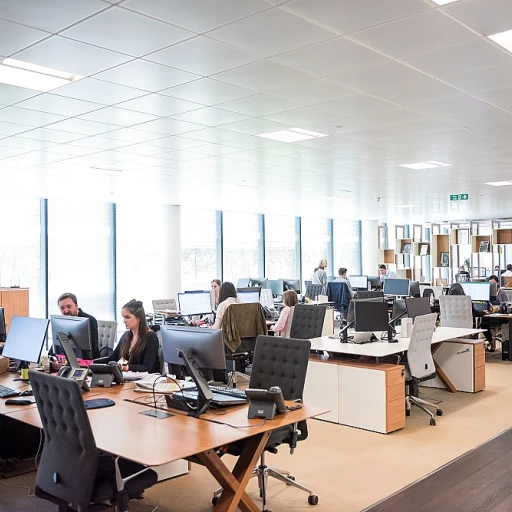Understanding the Importance of Office Safety
The Role of Office Safety in a Productive Environment
Ensuring a safe office environment is not just about complying with legal requirements; it also plays a vital role in creating a productive workplace. A well-protected office means fewer accidents and disruptions, leading to increased focus and efficiency among staff members. This lower risk of injury and accident also helps in reducing absenteeism, ultimately benefiting the company's bottom line.Enhancing Employee Morale Through Safety
When managers prioritise office safety, it demonstrates a commitment to employee wellbeing. This can significantly boost morale, as employees feel valued and protected. People perform better when they know their health and safety are being taken seriously, fostering a culture of trust and loyalty within the organisation.Building a Foundation for Comprehensive Training
A strong safety culture begins with a solid foundation of understanding the importance of risk management. Managers are pivotal in cultivating this atmosphere by participating in comprehensive safety training programs. These programs not only equip them with the knowledge to maintain safety protocols but also empower them to lead by example. For those looking at how to maintain a pristine and orderly environment as part of an overall safety strategy, understanding office cleaning service companies can prove beneficial. Keeping a clean workspace is a fundamental aspect of safety, contributing to a healthy atmosphere where employees can work without the threat of contamination or clutter-related accidents.Key Safety Services for Managers
Essential Safety Measures for Enhancing Workplace Security
In the dynamic world of office management, ensuring a safe and secure workplace for all employees is paramount. Managers are at the forefront, responsible for implementing a variety of safety services that maintain and enhance office environment security. This section focuses on some of the critical safety services that managers can leverage to create a robust safety framework.Implementing Routine Safety Audits
Routine safety audits are crucial for identifying potential hazards and ensuring compliance with health and safety regulations. These audits help managers pinpoint areas that require attention and adjustments, promoting an environment where safety is a continuous priority rather than a sporadic consideration.Emergency Preparedness and Response
Training employees on emergency preparedness is essential for any office. Managers should ensure that there are clear evacuation plans in place, regular fire drills, and accessible emergency kits. Communication plays a key role in crisis management, and having pre-established protocols ensures everyone knows how to react swiftly and correctly during emergencies.Ergonomic Workstation Design
Workstation ergonomics can significantly impact the health and well-being of employees. By investing in ergonomic furniture and equipment, managers can reduce the risk of short and long-term musculoskeletal disorders. Additionally, educating staff on proper posture and workstation arrangement can further diminish potential health risks.Prioritising Mental Health and Well-being
Office safety extends beyond physical dangers; mental health is equally important. Managers can introduce programs that support mental well-being, providing resources such as counselling services, workshops on stress management, and encouraging a supportive work culture. For more tips on maintaining a clean and safe work environment, consider exploring our guide on finding the best office cleaning service companies. Keeping a clean office not only contributes to overall safety but also boosts employee morale and productivity. By integrating these safety services, managers can foster a workplace culture that prioritises security, health, and well-being, laying down a strong foundation for a safe working environment for all employees.Training Programs: Building a Strong Safety Culture
Fostering a Safety-Conscious Team
Creating a safety-conscious team is pivotal in cultivating a robust safety culture within the workplace. Managers have the responsibility to ensure that every team member, regardless of their role, understands the importance of maintaining a safe work environment. This can be achieved through comprehensive training programs specifically designed to equip employees with the necessary knowledge and skills to identify potential safety risks and respond effectively.The Role of Tailored Safety Training Programs
Tailored safety training programs are designed to meet the unique needs of each department and job function, fostering an environment where safety is prioritized. These programs should include practical, hands-on training that allows employees to experience real-life scenarios and learn how to handle them competently. When employees are well-trained, they become more confident in their ability to handle emergencies, thereby reducing the likelihood of accidents and injuries in the workplace.Collaboration for Continuous Improvement
Regularly updating training programs and including input from employees encourages a culture of continuous improvement. By taking feedback into account, managers can identify gaps in existing training and introduce new elements that address emerging safety concerns. This collaborative approach not only improves the effectiveness of training programs but also increases employee engagement and accountability.Choosing the Right Partners for Training Excellence
Selecting the appropriate partners to facilitate these training programs is crucial. Working with proven experts ensures that the sessions are insightful and aligned with the latest industry standards and regulations. To make informed decisions on the best partners for your office training needs, consider choosing facility maintenance partners that are well-versed in safety management. By engaging the right partners, managers can enhance their office safety protocols and foster a proactive safety culture.Navigating Health and Safety Regulations
Comprehending Health and Safety Regulations
Navigating the labyrinth of health and safety regulations is a crucial responsibility for managers aiming to maintain a secure office environment. Being well-versed in these regulations not only helps in preventing legal repercussions but also fosters a safer workplace. Adhering to the Health and Safety at Work Act and other pertinent legislation ensures the organisation's commitment to employee well-being. Managers should become familiar with risk assessments, as they are a cornerstone of health and safety management. Regular assessments enable the identification and mitigation of potential hazards, ensuring that preventive measures are up-to-date and effective. It is essential to consult with legal and safety professionals who can provide guidance on compliance and best practices. Furthermore, maintaining clear communication with employees about health and safety responsibilities is vital. This transparency empowers teams to take proactive measures in their daily activities, thereby strengthening the collective safety culture. Regular updates and training sessions can keep everyone informed about any changes in legislation or company policies, as discussed in the section on training programs and safety culture. By consistently updating policies and ensuring compliance, managers can create a safer workplace that prioritizes both productivity and the health of its employees. Engage with safety specialists and use modern tools to streamline compliance processes and make the task more manageable for your team. These measures not only safeguard your employees but also enhance the company's reputation as a responsible and caring employer.Addressing Common Workplace Hazards
Identifying and Mitigating Common Workplace Hazards
Ensuring a safe office environment is an essential duty for managers, as it not only contributes to the well-being of employees but also enhances overall productivity. As a manager, recognising common workplace hazards and effectively addressing them forms a crucial aspect of developing a robust safety framework. Workplace hazards can emerge in various forms ranging from physical, such as slip and fall risks and ergonomic issues, to environmental hazards like air quality and lighting. Managers must be vigilant in identifying these risks regularly. Implementing regular inspections and safety audits can go a long way in detecting potential issues early on. Moreover, it is essential to involve employees in this process, encouraging them to report hazards they encounter. This can foster a safer working environment and helps to cultivate a safety-focused culture, essential for any thriving business. Equally important is the role of safety equipment and protocols, ensuring that all safety measures are up to date and thoroughly practiced by all members of the team. Utilising posters, emails, and briefings to communicate safety policies effectively ensures that everyone is on the same page when it comes to maintaining a safe workplace. Regular training programs (as discussed earlier in part 3) can significantly assist in preparing employees and managers alike to handle hazards efficiently, empowering them with knowledge about emergency procedures and protocols. This understanding not only prevents accidents but also provides confidence in managing unexpected incidents. By keeping a proactive approach to hazard management, managers can significantly contribute to a safer and more harmonious office environment, reflecting a dedicated commitment to staff welfare and organisational success.Leveraging Safety Consultants for Effective Management
Maximizing the Benefits of Safety Consultants
Engaging with safety consultants can be a game-changer for managers aiming to enhance office safety. These experts bring a wealth of knowledge and experience, offering tailored solutions that align with your specific workplace needs. They provide an external perspective, which is invaluable in identifying potential risks and developing strategies to mitigate them.
Safety consultants can assist in implementing the key safety services discussed earlier, ensuring that your office environment is both safe and compliant with regulations. Their role often involves conducting thorough risk assessments, which are crucial in addressing common workplace hazards. By leveraging their expertise, managers can foster a proactive safety culture, which is essential for long-term success.
Moreover, consultants can guide you through the complexities of health and safety regulations, making sure your office adheres to all legal requirements. This not only helps in avoiding potential fines but also boosts employee morale and productivity by creating a secure working environment.
Incorporating the insights and recommendations from safety consultants into your office management strategy can lead to significant improvements in safety performance. As managers, embracing these resources is a step towards a safer, more efficient workplace.




-large-teaser.webp)








